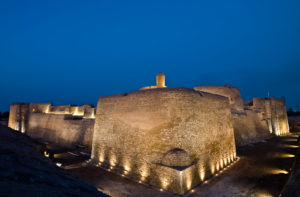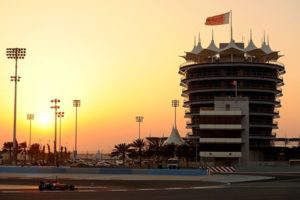Bahrain is a tourist destination and one of the most visited countries in Middle East. It’s kingdom combines modern Arab culture and historical places which reflects five thousand years of Bahrain civilization. It’s climate is mostly hot and dry in summer season with low level wind directed toward Bahrain through the Zagros Mountains across the Persian Gulf. There is no regularity for rainy season, mostly rainfall occur in winter season. Bird watching, scuba diving and horse riding are popular tourist activities in Best Tourist Places in Bahrain.
1). Tree of Life
 The Tree of Life, a 400-year old mesquite tree in Bahrain whose survival in an area completely free of water supply has made it a legend. The unique tree, standing alone in the heart of the desert, about two kilometres from Jebel Dukhan, Bahrain’s highest
The Tree of Life, a 400-year old mesquite tree in Bahrain whose survival in an area completely free of water supply has made it a legend. The unique tree, standing alone in the heart of the desert, about two kilometres from Jebel Dukhan, Bahrain’s highest
point, is one of few Arab entries under the category forest, natural parks, and nature reserves. Mesquites yield yellowish gums used in making mucilage, candles and dyes.
When standing under the spreading limbs of this tree that graces a patch of Bahrain’s southern desert, with earth movers scraping the escarpment for cement, and oil and gas pipelines running alongside, it’s hard to imagine anywhere less deserving of the name ‘Garden of Eden’. And yet, modern scholars point to several ancient sources that suggest Bahrain may have been the locus of paradise. In the Babylonian creation myth, the Epic of Gilgamesh, Dilmun (Bahrain’s ancient incarnation) is described as the home of Enki (the god of wisdom), the Sweet Water from Under the Sea, and Ninhursag (goddess of the Earth). Likewise, in the Old Testament, it is possible that Hebrew and Sumerian traditions of paradise are similarly conflated. On encountering this Tree of Life, however, you may well urge archaeologists searching for Eden to keep looking!
Designed by Belienska Basmaji, the tree of life visitor’s centre is conceived as a protective circular fence that protects the tree from cars and vandalism while offering a shelter from which people can contemplate the tree from a distance. The visitor’s centre will also include archaeological artifacts, which were uncovered on site, as well as a small stage for outdoor performances and events.
2). Bab Al Bahrain, Manama
Bab-Al-Bahrain is one of the most beautiful market in a Manama having number of stalls lined selling veggies and fruits, clothes, crafts, and is one of the best historically selling gold and pearls. an arched gate is for the entrance of the market with a beautiful fountain at the front of the gate. whole area gives a picture of true beauty and place for soothing. many luxury hotels are also nearer to the market.
3). Qal’at Al-Bahrain
 On Arabian peninsula an archaeological site with height if 39ft is found in Bahrain, it is 6km away from Manama city. it is a place with a huge amount of antiques. it is the capital of Dilmun. It is a seven stratified layered fort, which is spread over 10,000 sq ft.it has a mounded structure and about 12m high is a fort which gives name to this historic area. the structure shows a small settlement in the past were small houses are made of binding material. this whole area gives a beautiful look to the eye.
On Arabian peninsula an archaeological site with height if 39ft is found in Bahrain, it is 6km away from Manama city. it is a place with a huge amount of antiques. it is the capital of Dilmun. It is a seven stratified layered fort, which is spread over 10,000 sq ft.it has a mounded structure and about 12m high is a fort which gives name to this historic area. the structure shows a small settlement in the past were small houses are made of binding material. this whole area gives a beautiful look to the eye.
4). Al Areen Wildlife Park
40 minutes away from Manama Center is Al Areen wildlife park a best tourist spot activity in Bahrain. this lush green park has a huge number of flora ad fauna, including more than 500 species of animals and 10,000 plants. it has 2 parts, one of which is open for people and the other one is the reserve area. this park is annually attracted by a great number of visitors.
5). Bahrain International Circuit
 The Bahrain International Circuit (BIC) is one of the world’s premier motor sport facilities. Under the direction of His Royal Highness Prince Salman bin Hamad Al Khalifa, a passionate motor sport enthusiast, the Kingdom worked closely with Formula One in creating the most innovatively designed track in the world, equipped with the most cutting edge technology and supported by the world–class infrastructure. At the inaugural race in 2004, the BIC was awarded the ‘Best Organised Grand Prix’ by the FIA.
The Bahrain International Circuit (BIC) is one of the world’s premier motor sport facilities. Under the direction of His Royal Highness Prince Salman bin Hamad Al Khalifa, a passionate motor sport enthusiast, the Kingdom worked closely with Formula One in creating the most innovatively designed track in the world, equipped with the most cutting edge technology and supported by the world–class infrastructure. At the inaugural race in 2004, the BIC was awarded the ‘Best Organised Grand Prix’ by the FIA.
6). Bahrain National Museum
The Bahrain National Museum is the crowning achievement of the Kingdom of Bahrain’s ongoing efforts to preserve the nation’s heritage and history; Efforts which began in 1957 when the first exhibition of the artefacts discovered by the Danish archaeological expedition was held at Al-Hidaya Al-Khalifiya in Muharraq.
The museum was inaugurated in 1988 by the late Emir Shaikh Isa bin Salman Al Khalifa in a grand ceremony attended by His Royal Highness Prince Khalifa bin Salman Al Khalifa, the Prime Minister, and then Crown Prince His Majesty King Hamad bin Isa Al Khalifa.
Built on a central location between Manama and Muharraq, Bahrain National Museum houses 9 main halls, and classifies the accumulated heritage of the Kingdom of Bahrain into 6 different sections. Visitors to the museum will be taken on a 4,000 year journey through time as they pass through its halls, from the traditional handicrafts hall, to the customs and traditions hall, burial mounds hall, ancient documents and manuscripts hall, Tylos hall, and Islamic period hall.
The museum seeks not only to enhance understand and knowledge of Bahrain’s history amongst locals only, but also play a role as an institutions which promotes global culture within the community, as evidenced by the numerous international culture and art exhibitions it has hosted over the years.
7). Al Fateh Grand Mosque
 Al Fateh is the mosque in Bahrain which is capable of reconciling audience of 7000 and is one of the largest mosques. this mosque was built in 1988.it was built with marble, glass and teak wood. the most attractive thing is the dome of the mosque which is made up of fiber glass and gives a fascinating view at night and the largest dome.
Al Fateh is the mosque in Bahrain which is capable of reconciling audience of 7000 and is one of the largest mosques. this mosque was built in 1988.it was built with marble, glass and teak wood. the most attractive thing is the dome of the mosque which is made up of fiber glass and gives a fascinating view at night and the largest dome.
8). Oil Museum and first oil well
Built in 1992 to mark the 60th anniversary of the discovery of oil, this museum is housed in a grand, white-stone building quite out of keeping with the surrounding nodding donkeys and sprawling pipelines. In the shadow of Jebel ad-Dukhan (Mountain of Smoke) – Bahrain’s highest point at just 134m – the building is a befitting symbol of the country’s wealth, for it marks the point at which ‘black gold’ was struck for the first time on the Arabic side of the Gulf.
The museum has exhibits, photographs and explanations about the oil industry in Bahrain. A few metres away, you can see the country’s first oil well, which was constructed in 1932.
Ring ahead to check opening times, as the museum is seldom visited despite being clearly signposted along an unmarked road south of Awali. There is no bus service to this region. By car, it takes about 40 minutes to reach the museum, which is 35km south of Manama.
9). A’Ali Burial Mounds
To gain an idea of the significance of these burial mounds on the approach to A’Ali, visit Manama’s Bahrain National Museum beforehand. The mounds, which date from the Dilmun period, encase burial chambers used for all members of society, young and old. At 15m in height and 45m in diameter, the tallest mounds are referred to as the ‘Royal Tombs’, and it’s easy to see why: they give A’Ali, an otherwise humble town of potters and bakers, a regal presence.
10). Bahrain National Theater
Bahrain National Theatre opened in November 2012 under the patronage of His Majesty King Hamad bin Isa Al Khalifa. Built on an area of about 12,000 m2 overlooking the sea, the 1,001-seat theatre is located next to the Bahrain National Museum. Its unique architectural design and wood-covered interior walls draw inspiration from the tales of 1,001 Arabian Nights. The Bahrain National Theatre is one of the largest theatres in the Arab world, and is the third largest opera house in the Arab world after the Cairo Opera House in Egypt and the Royal Opera House Muscat in Oman.
Bahrain National Theatre is considered the crowning achievement in the Kingdom’s longstanding efforts to enrich and develop local culture for many decades as evidenced by a history full of achievements, including establishing the first school in the GCC in 1925 and the first radio station in 1941, in addition to a large number of cultural halls and institutes.



